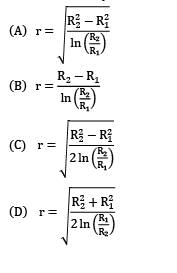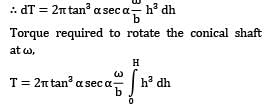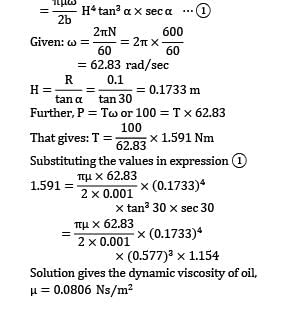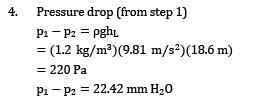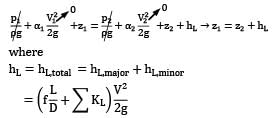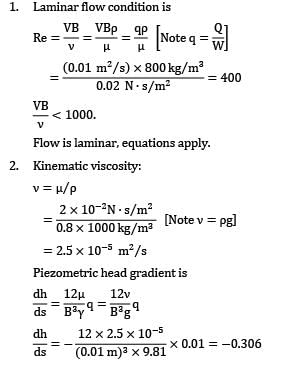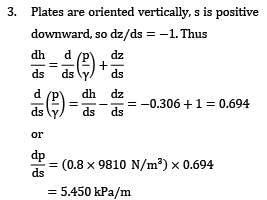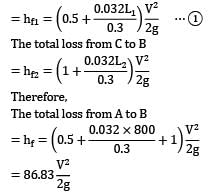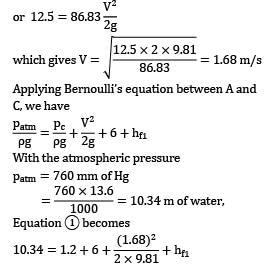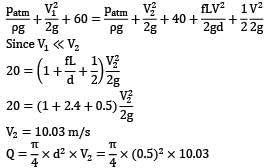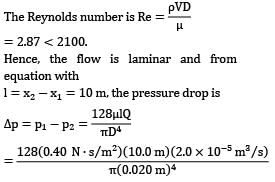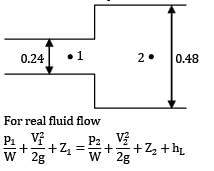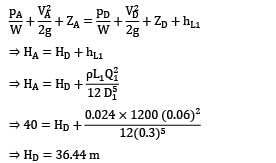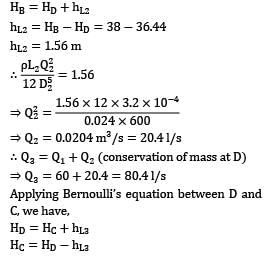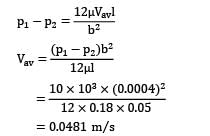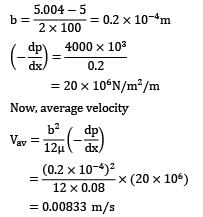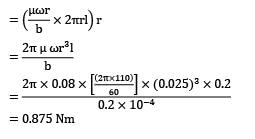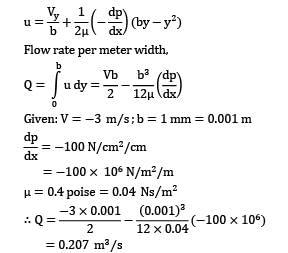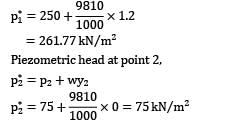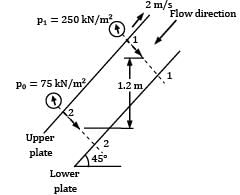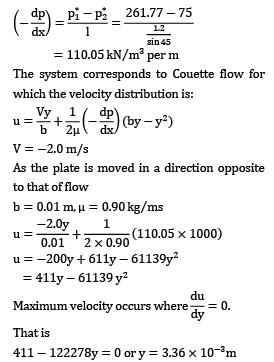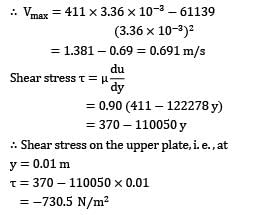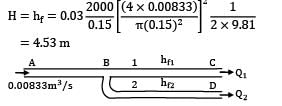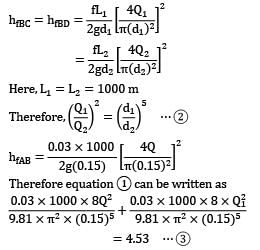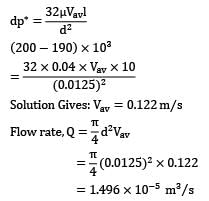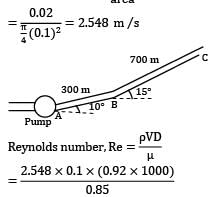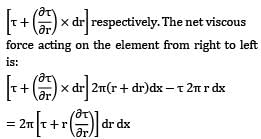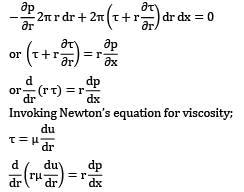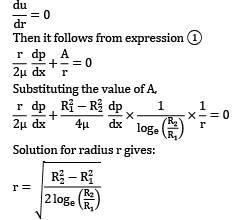Test: Viscous Flow of Incompressible Fluids, Flow Losses Level - 3 - Mechanical Engineering MCQ
20 Questions MCQ Test - Test: Viscous Flow of Incompressible Fluids, Flow Losses Level - 3
For a conical bearing, 100 watt power gets dissipated when a shaft with maximum cone radius 10 cm turns with 600 rpm over a uniform fluid layer of thickness 0.1 cm. If semi-angle for the conical bearing is 30°, make calculations for the dynamic viscosity of the fluid (in SI units).
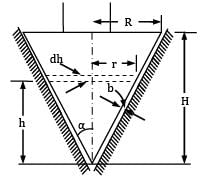

Air (T = 20°C and p = 101kPa absolute) flows at a rate of 2.5 m3⁄s in a horizontal, commercial steel, HVAC duct of 0.3 m × 0.6 m. (Note that HVAC is an acronym for heating, ventilating, and air conditioning.) What is the pressure drop in mm of water per 50 m of duct? (Darcy friction factor, f = 0.015)
Water at 10°C flows from a large reservoir to a smaller one through a 5-cm-diameter cast iron piping system, as shown in Fig. Determine the elevation z1 (in m) for a flow rate of 6 L/s.
The density and dynamic viscosity of water at 10° C are ρ = 999.7 kg⁄m3 and μ = 1.307 × 10−3 kg⁄m ∙ s. The coefficient of friction = 0.0315.


Oil having a specific gravity of 0.8 and a viscosity of 2 × 10−2 N ∙ s/m2 flows downward between two vertical smooth plates spaced 10 mm apart. If the discharge per meter of width is 0.01 m2⁄s, what is the pressure gradient dp⁄ds for this flow? Give your answer in kPa/m.
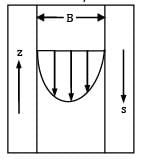
Two reservoirs open to the atmosphere are connected by a pipe 800 metres long. The pipe goes over a hill whose height is 6 m above the level of water in the upper reservoir. The pipe diameter is 300 mm and friction factor f = 0.032. The difference in water levels in the two reservoirs is 12.5 m. If the absolute pressure of water anywhere in the pipe is not allowed to fall below 1.2 m of water in order to prevent vapour formation, calculate the length of pipe in the portion between the upper reservoir and the hill summit. Neglect bend losses.
Water (T = 20°C) flows from a tank through a 50 cm diameter steel pipe. Determine the discharge of water in m3/s. (Friction factor = 0.012)
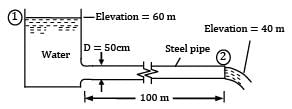
Properties: 1. Water at 20°C, ν = 1 × 10−6 m2⁄s 2. The Darcy friction factor = 0.012 Also consider all possible losses in the flow.
Water ρ = 1000 kg/m3and ν = 1.02 × 10−6 m2/s is pumped between two reservoirs at 5.66 × 10−2 m3/s through 122 m of 5.1 cm diameter pipe and several minor losses, as shown in Fig. Compute the pump power required in kW. f = 0.0216
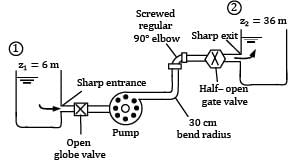
| Loss | K |
Sharp entrance Open globe valve 30 cm bend Regular 90° elbow Half-closed gate valve Sharp exit | 0.5 6.9 0.25 0.95 2.7 1.0 |
An oil with a viscosity of μ = 0.40 N ∙ s⁄m2 and density ρ = 900 kg⁄m3 flows in a pipe of diameter D = 0.020 m.
(i) What pressure drop, p1 − p2 , is needed to produce a flow rate of Q = 2.0 × 10−5 m3⁄s if the pipe is horizontal with x1 = 0 and x2 = 10 m?
(ii) How steep a hill, θ must the pipe be on if the oil is to flow through the pipe at the same rate as in part (a), but with p1 = p2?
A sudden enlargement of a water pipeline from a diameter of 0.24 m to 0.48 m. The HGL rises by 10 mm. Then find the discharge in m3/s.
Three reservoirs A, B and C are connected by a pipe system as shown in figure. The height of water level in reservoir C is __________ m. Take f = 0.024 for all pipes.
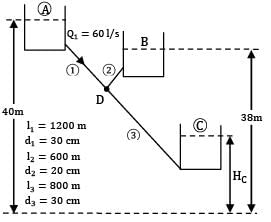
Air flowing into a 2-ft–square duct with a uniform velocity of 10 ft/s forms a boundary layer on the walls as shown in Fig. The fluid within the core region (outside the boundary layers) flows as if it were inviscid. From advanced calculations it is determined that for this flow the boundary layer displacement thickness is given by δ∗ = 0.0070(x)1⁄2 where δ∗ and x are in feet. Determine the velocity U = U(x) of the air within the duct but outside of the boundary layer.
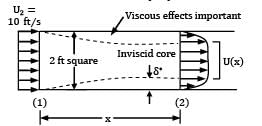
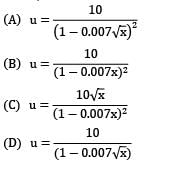
A container full of oil has a horizontal parallel crack in its end wall which is 500 mm wide and 50 mm thick in the direction of flow. The pressure difference between two faces of the crack is 10 kPa and the crack forms a gap of 0.4 mm between the parallel surfaces.
Calculate
(i) Maximum leakage velocity;
(ii) Shear stress at the boundary.
Take specific gravity and viscosity of oil equal to 0.85 and 1.8 poise respectively.
A spindle 5 cm in diameter turns 110 revolutions per minute in a bearing 5.004 cm internal diameter. The intervening space is filled to 20 cm depth with a lubricating oil of dynamic viscosity 0.08 Pa‑s. If the oil pressure is 4000 kPa, make calculations for the oil leakage along the spindle and the resisting torque due to viscous drag of the oil film.
Determine the amount of flow (in m3 /s) per meter width between two parallel plates when one is moving relative to the other with a velocity of 3 m/s in the negative x-direction, if dp /dx = −100 N⁄cm2 /cm, μ is 0.4 poise and the distance between the plates is 1 mm.
Laminar flow of a fluid of viscosity 0.90 kg⁄ms and mass density 1250 kg⁄m3 occurs between a pair of plates of extensive width; the plates are 10 mm apart and are inclined at 45 degree to the horizontal. Pressure gauges mounted at two points 1.2 m vertically apart on the upper plate record pressure of 75 kN⁄m2 and 250 kN⁄m2 at the lower and upper point respectively. The upper plate moves with a velocity of 2.0 m⁄s relative to the lower plate but in a direction opposite the fluid flow. Make calculations for (i) the maximum flow velocity, and (ii) the shear stress on the upper plate.
Two reservoirs are connected through a 300 mm diameter pipe line, 1000 m long as shown in figure. At a point B, 300 m from reservoir A, a valve is inserted on a short branch line which discharges to the atmosphere. The valve may be regarded as a rounded orifice 75 mm diameter, Cd = 0.65. If friction factor f for all the pipes is 0.013. Estimate the leakage through the short pipe line at B (in m3/s).

A pipeline conveys 8.23 litre per second of water from an overhead tank to a building. The pipe is 2 km long and 0.15 m in diameter. It is desired to increase the discharge by 30% by installing another pipeline in parallel with this over half the length. Suggest a suitable diameter of the pipe to be installed. Is there any upper limit on discharge augmentation by this arrangement? (Take friction factor f = 0.03. )
A liquid of dynamic viscosity 0.04 Pa s and specific weight 8 kN⁄m3 is being pumped through a pipe of 1.25 cm diameter laid on slope as shown in Fig. For the pressures indicated, work out the direction and rate of flow (in ml/s) through the pipe.

A pipe 10 cm in diameter and 1000 m long is used to pump oil of viscosity 3.5 poise and specific gravity 0.92 at the rate of 1200 litre/min. The first 300 m of the pipe is laid along the ground sloping upwards at 10° to the horizontal and the remaining pipe is laid to the ground sloping upwards at 15° to the horizontal. Determine the power (in kW) of the driving motor if the pump efficiency is 60 percent. Assume suitable data for friction coefficient f, if required.
A circular pipe of radius R1 is placed concentrically inside another pipe of radius R2. If the flow in the annular space between the pipes is laminar. Find the r where maximum velocity occurs.



